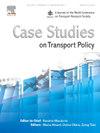Manufacturing differences of mobility: The division of food-delivery modes on food-delivery platform in China
IF 3.3
Q3 TRANSPORTATION
引用次数: 0
Abstract
Food-delivery riders have become an important part of urban transportation. The dangerous road behaviour of riders challenges traffic laws and presents a complex problem for labour protection. Therefore, it is necessary to develop a deeper understanding of how the mobility of food-delivery riders is shaped by power and inequality. This article claims that mobility issues should be central to understanding food-delivery labour, as existing research generally overlooks mobility theory. Chinese food-delivery giant Meituan’s management practice of dividing riders into different food-delivery modes provides a case study for examining how platforms create differences in mobility and intervene in riders’ labour practices. Between March 2023 and April 2024, the first author worked as a rider and conducted in-depth interviews with 20 riders in Beijing. This article first introduces the core differences between Meituan’s different food-delivery modes. Drawing on motility theory as an analytical framework, the study further finds that the division of food-delivery modes is based on the dominant power of food-delivery platforms over order allocation. Riders tend to choose the food-delivery mode with a higher order volume but lower unit prices and more management requirements to obtain more order resources. Consequently, the platform reduces labour costs by dividing food-delivery modes, while riders need to strengthen their mobility skills to meet the high mobility requirements of the mode they chose. For transport policy, more consideration needs to be given to improving riders’ access to mobility through transportation infrastructure and law enforcement to prevent riders from violating traffic rules as their preferred option for enhancing mobility.
流动性的制造差异:中国外卖平台上外卖模式的划分
外卖骑手已经成为城市交通的重要组成部分。骑车者的危险道路行为挑战了交通法规,并提出了一个复杂的劳动保护问题。因此,有必要更深入地了解送餐骑手的流动性是如何受到权力和不平等的影响的。这篇文章声称流动性问题应该是理解食品配送劳动力的核心,因为现有的研究通常忽略了流动性理论。中国外卖巨头美团将骑手分为不同的送餐模式的管理实践,为研究平台如何创造流动性差异并干预骑手的劳动实践提供了一个案例研究。在2023年3月至2024年4月期间,第一作者以骑手的身份在北京对20名骑手进行了深度采访。本文首先介绍了美团不同外卖模式的核心区别。以动力理论为分析框架,进一步发现外卖模式的划分是基于外卖平台对订单分配的主导权。骑手倾向于选择订单量大、单价低、管理要求高的送餐模式,以获得更多的订单资源。因此,该平台通过划分送餐模式来降低劳动力成本,而骑手需要加强他们的移动技能,以满足他们选择的模式的高移动性要求。对于交通政策,需要更多地考虑通过交通基础设施和执法来改善乘客的机动性,以防止乘客违反交通规则,这是他们增强机动性的首选选择。
本文章由计算机程序翻译,如有差异,请以英文原文为准。
求助全文
约1分钟内获得全文
求助全文

 求助内容:
求助内容: 应助结果提醒方式:
应助结果提醒方式:


